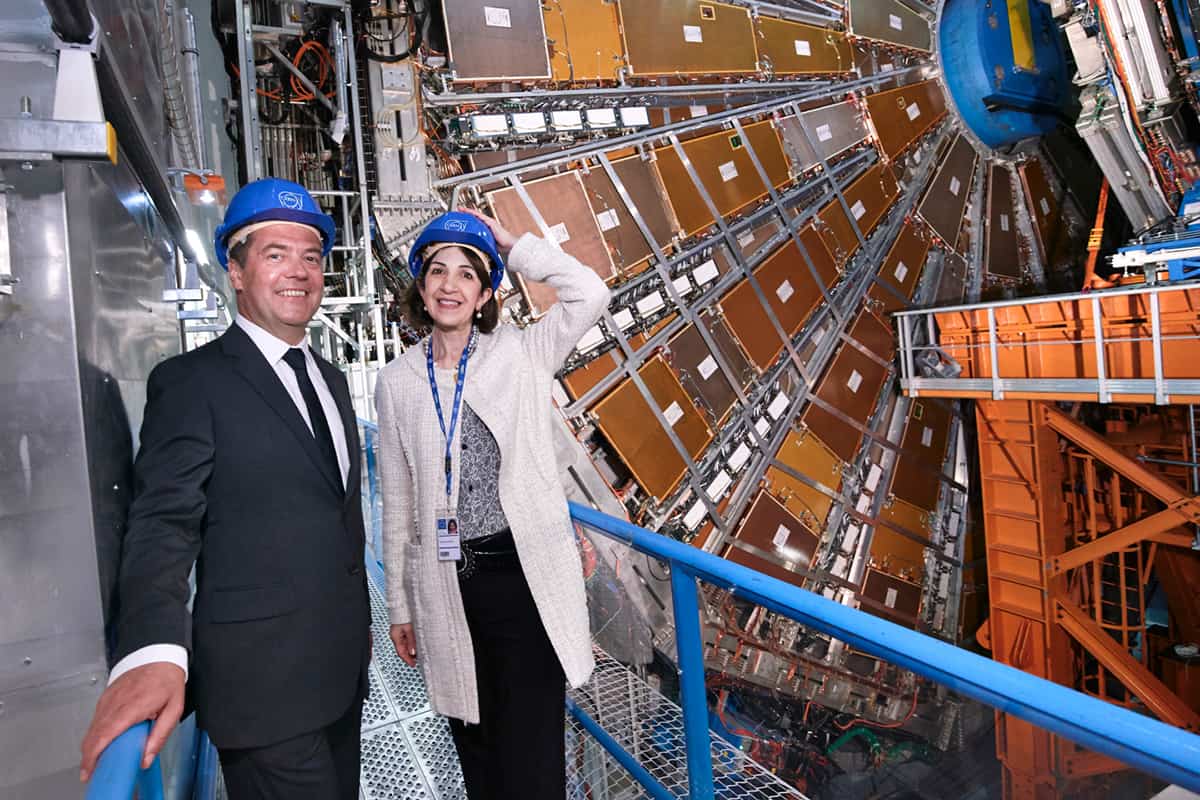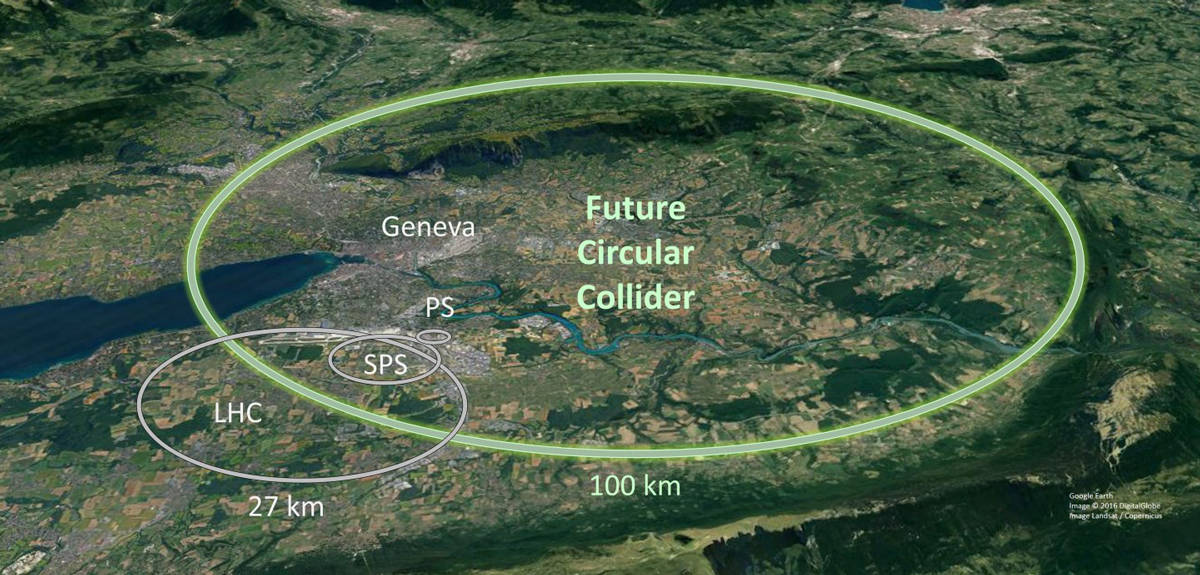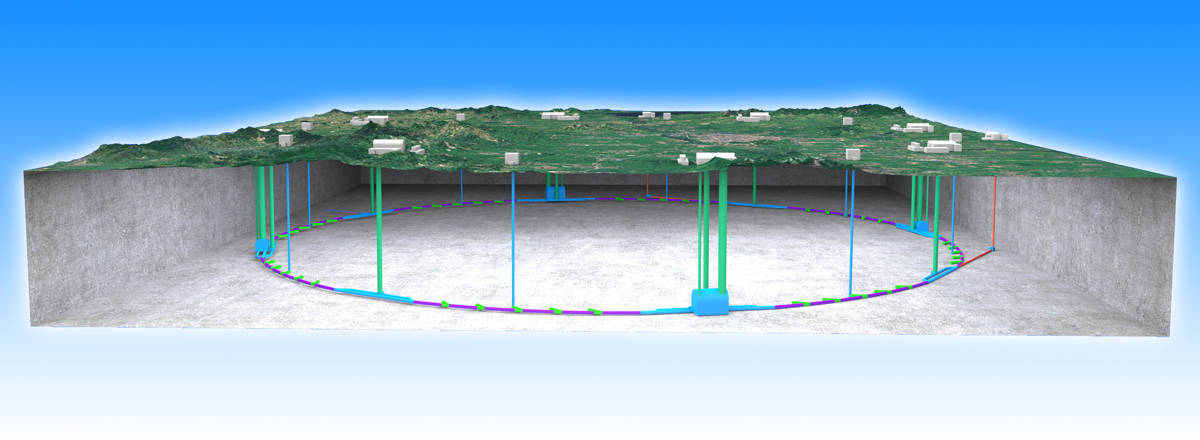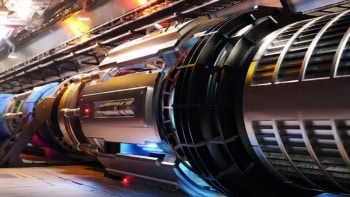A decade after the discovery of the Higgs boson at CERN, Michael Riordan worries that the glory days of international co-operation in particle physics could be endangered following Russia’s invasion of Ukraine

Ten years ago this month, on 4 July 2012, two of the largest scientific collaborations in history – ATLAS and CMS – announced the discovery of the long-sought Higgs boson at CERN. Researchers from more than 60 nations spanning six continents could all rejoice together in what will surely stand as one of this century’s greatest scientific breakthroughs. It was a remarkable achievement of international co-operation too, happening at a singular moment of relative world peace.
Part of CERN’s success as a citadel of modern physics was the decision to base it in Switzerland – a nation long renowned for its political neutrality. Thousands of physicists of diverse nationalities, including Britons, Germans, Italians, Poles, Russians, Ukrainians, Indians, Chinese and Americans have converged on the Geneva-based lab. Since it was founded in 1954, CERN has nurtured a talented and cohesive workforce that successfully managed the difficult construction of the multibillion-euro Large Hadron Collider (LHC) and its four gargantuan particle detectors. All of these developments culminated in the 2012 discovery of the Higgs boson, the capstone of the Standard Model of particle physics.
But international co-operation in particle physics is now threatened by Russia’s savage invasion of Ukraine, which has seriously disrupted the existing post-Cold-War world order. In its regular 17 June 2022 meeting, CERN’s governing council voted to terminate its co-operation agreements with Russia (and Belarus) at their 2024 expiration dates after its attack on a laboratory associate member. It was a stunning policy reversal that excludes Russian institutes from involvement in new scientific projects, subject to further review.
For the first time, high-energy physics is closing its doors to certain nations. This is a worrisome turn of events. Russian physicists – and their Soviet counterparts before them – had been involved in CERN for almost half a century since taking part in experiments on the Super Proton Synchrotron in the mid-1970s. Russia’s later contributions to the LHC and its detectors were valued at an estimated $60m – indeed, an analysis by Sergei Smirnov of the National Research Nuclear University in Moscow suggests they were worth much more if the country’s cheaper labour and manufacturing costs are taken into account (J. Phys. Conf. Ser. 1406 012003). Deeply involved in both the ATLAS and CMS experiments, Russian physicists shared due credit for the Higgs boson discovery.
Higgs factories
Russia’s likely exclusion from CERN is not the only example of an alarming pullback from international co-operation in high-energy physics. Earlier this year, a panel appointed by Japan’s Ministry of Education, Culture, Sports, Science and Technology (MEXT) expressed serious reluctance to proceed with plans for the International Linear Collider (ILC) – a new, technologically sophisticated, multibillion-dollar high-energy electron–positron collider targeted for construction in Japan.
Prospects for the ILC had initially looked encouraging. In February 2013, just eight months after the Higgs discovery, the ILC Global Design Effort published a five-volume technical design report that set forth a baseline design and the remaining R&D required before construction could start. Physicists in Japan even pinpointed two proposed sites for the collider. But nine years and multiple stumbling blocks later, that promising international endeavour seems to have stalled.
Part of the reason for the panel’s decision to “shelve the question of hosting the ILC” was the uncertainty over international commitments. It was too early for Japan to start building the ILC, the panel felt, calling for more research and additional overseas support for the project. And Japan unfortunately suffers from a limited history of hosting large international physics collaborations. Sure, the Belle experiment at the KEKB collider in Tsukuba involved physicists from nearly 100 institutions in 22 countries, but most of those were other Asian nations, and that detector cost just tens of millions of dollars.
A decade after the discovery of the Higgs boson, therefore, high-energy physics does not yet have a clear path to building an electron–positron collider, – dubbed a “Higgs factory” because it would produce huge amounts of Higgs bosons. The absence is particularly unsettling because this kind of machine sits high on particle physicists’ wish lists. The 2020 European Strategy for Particle Physics, for example, declared a Higgs factory to be “the highest-priority next collider” as it would allow physicists to measure the particles’ behaviour with high precision (see box “Towards a Higgs factory”).
The lack of a clear path forward for Higgs studies lies in stark contrast to the situation after the Z boson, which carries the weak force, was discovered at CERN in 1983. Barely six years later, there were not one but two “Z factories” in operation – the Large Electron–Positron (LEP) facility at CERN and the SLC at the Stanford Linear Accelerator Center (SLAC) in the US. Built at well-established labs, both electron–positron colliders could create large numbers of this massive particle. But a decade after the Higgs boson turned up, the way forward remains uncertain.
Given Japan’s hesitation over the ILC, it now appears that the leading candidate for a Higgs factory is China’s proposed Circular Electron Positron Collider (CEPC). It would be built by Beijing’s Institute for High-Energy Physics (IHEP), which is spearheading the proposal. Featuring dual rings of ambient-temperature iron magnets and two sets of superconducting accelerating cavities at two opposite points around the ring, this 100 km-circumference machine would generate collisions at 240 GeV – high enough to produce many thousands of Higgs bosons paired with Z bosons.
Its advertised cost is in the order of $6bn, paid largely by the Chinese government, which can probably afford this price tag, given its strong economy and trade surpluses. Construction could potentially start in the next few years, if given the go-ahead. But it will be a huge challenge. Such an immense machine would be hundreds of times larger and costlier than any project IHEP has ever attempted. The project will probably have to be managed and directed by people outside high-energy physics – professional engineers (possibly from Chinese military backgrounds) who are experienced at building large projects but not in establishing an all-important laboratory culture. Engineers are essential for such huge projects, of course, but they must not gain the upper hand over the scientists.
We have already seen this happen with the ill-fated Superconducting Super Collider (SSC), a colossal high-energy physics machine that the US tried to build in Texas rather than in Illinois adjacent to Fermilab. Then America’s premier high-energy physics lab, Fermilab had experienced accelerator physicists able to manage such an enormous project. Several factors lay behind the decision by the US Congress in 1993 to cancel the project, not least the internecine politics of Washington, DC. But mismanagement of the SSC (whether real or perceived) by a contentious organization of accelerator physicists and ex-military managers contributed to its downfall.
“The Chinese are very sophisticated in accelerator design, construction and operations,” says Barry Barish, the 2017 Nobel-prize-winning physicist from the California Institute of Technology, who is a member of the CEPC’s international advisory board and who headed the ILC Global Design Effort from 2005 to 2013. “But for large and expensive construction, they will undoubtedly bring in Chinese industry and other expertise.” Such external influences could easily compromise the resulting laboratory’s nascent scientific culture at a critical point in its evolution.
Voicing related concerns in a 2017 Foreign Policy article, the Chinese-born particle physicist Yangyang Cheng (now at Yale Law School) questioned whether the scientific values of international co-operation and camaraderie were “compatible with an authoritarian state that’s increasingly hostile to foreign ideas at home and which sees science as a tool for national greatness”. Can the traditional openness of science, she wondered, thrive in a closed culture in which Communist Party members are often looking over scientists’ shoulders?

There are also practical questions, notably the fact that high-energy physics thrives on the rapid and unfettered exchange of information online. Spawned at CERN, the Web was first used there for international scientific collaboration. Construction of a modern particle collider like the CEPC would be impossible without such free and open communication. But as Cheng asked with regard to China’s pervasive Internet surveillance: “Can the future of particle physics exist within the Great Firewall of China?”
Of added concern are recent US restrictions imposed on Chinese-affiliated scientists working in America. First enacted under President Trump, those constraints have partly continued during the Biden administration. The US Department of Energy could have great difficulty sending serious money to the CEPC (should the need arise), while US physicists seeking to do Higgs research in China could face problems too. They may end up being replaced by funding and physicists from Russia, which could be permanently locked out of CERN’s future. Physicists from Belarus – a nation CERN has also excluded from future projects – may follow that example too.
In a curious way, the CEPC begins to resemble the SSC project, originally promoted by the Reagan administration as a means of re-establishing US leadership in high-energy physics. When its costs ballooned during the early 1990s after the Cold War ended, the first Bush administration tried fitfully to internationalize the project, ultimately focusing on Japan, which proved to be a difficult partner to draw in due to the SSC’s nationalistic founding rhetoric. The failure to secure significant international contributions to the ever-rising costs of collider construction was ultimately a prominent factor in that project’s demise.
Future CERN colliders
So could CERN build its own Higgs factory? It is certainly planning one. Various options are on the drawing board, notably the Future Circular Collider (FCC). It resembles the CEPC design, consisting of a 90–100 km underground ring that would initially house a 365 GeV electron–positron collider and could later be upgraded into a hadron collider, as happened with LEP and the LHC.
But CERN’s current expertise lies in hadron colliders, which are much more effective as particle “discovery” machines because of their far greater energy reach. The LHC, for example, collides protons at combined energies of nearly 14 TeV, which means that individual quarks and gluons inside them can collide at total energies well above 1 TeV. That’s much greater than the 240–365 GeV achievable in currently proposed electron–positron colliders.
Even if the FCC gets the green light, it would cost a staggering €10bn, and serious construction would not start until research on the LHC has finished in the mid-2030s. That would push the start-up of its physics research programme into the 2040s. By that decade, the CEPC (if built) could have mined most of the important Higgs-related physics, leaving the Higgs boson self-coupling and subsequent top-quark research for CERN.

Birthday boson: 10 years of living with the Higgs particle
But at least one can be sure that construction of the FCC will be able to draw on the CERN culture so conducive to conducting world-class high-energy physics research. Its accelerator physicists would also lead construction of the FCC’s second phase, which would see it converted into a 100 TeV proton–proton collider by installing powerful niobium–tin superconducting magnets that could generate fields of up to 16 T – nearly twice the level of current LHC magnets.
Equivalent expertise in superconducting magnet technology does not yet exist in China. Any attempt to convert the CEPC into a hadron collider would have to wait until such technology is developed there – or imported through international collaborations with European and US physicists. That’s where CERN has a huge advantage because of its decades-long experience with hadron colliders and superconducting magnets. It also already has the necessary proton injector for the planned FCC hadron collider: the LHC. Chinese physicists, in contrast, would have to design, build and operate such a sophisticated injector from scratch.
And from a different perspective, the FCC design process has been a truly international effort. At the time of writing, about 1400 physicists were officially involved in it, hailing from more than 135 institutions in 35 nations, and the numbers are steadily growing. A similar observation cannot be made for the CEPC, which has largely been a nationalistic effort aimed at establishing Chinese leadership in high-energy physics. Whereas CERN gradually developed the expertise to initiate and manage increasingly large projects, China is trying to build a far larger project than it has ever attempted – a much greater leap forward even than the US high-energy physics community attempted with the SSC.
And as the Nobel-prize-winning physicist and SLAC director Burton Richter often argued when the concept of the ILC was first mooted in the 1990s, international accelerator collaboration must begin early in the design phase. Not only will a project then benefit from the ideas and expertise of other nations, but those countries will later be much more likely to contribute funding and equipment if they know that their intellectual input has been included.
Towards a Higgs factory


CERN’s Large Hadron Collider (LHC) has been producing Higgs bosons since the particle was discovered in 2012, but particle physicists are now keen to build a “Higgs factory” to study its properties in greater detail. “A Higgs factory will produce thousands of times more Higgs bosons than identified at the LHC to date,” says John Ellis, a former CERN particle theorist, now at King’s College, London. “And it will do so in a clean environment that will make analysing them much easier.”
The advantage of electron–positron collisions is the absence of so many extraneous hadron tracks unrelated to the collision under examination, resulting in much less confusing backgrounds and smaller systematic errors. Such a machine would therefore allow physicists to determine Higgs couplings to quarks and leptons much more precisely (to accuracies of about 1–2% rather than the 10–20% achieved so far at the LHC).
In the Standard Model, these couplings are expected to be proportional to the decay-particle masses. Any small deviations from this linear behaviour would therefore indicate the presence of “new physics”. Supermassive particles at the TeV scale, for example, would break the inherent symmetry of the underlying physics equations. A Higgs factory would seek to shed light on this symmetry-breaking process and thus how elementary particles acquire mass.
Two main options for a circular electron–positron collider that could serve as a Higgs factory are currently on the drawing board. One is China’s Circular Electron Positron Collider, while the other is CERN’s Future Circular Collider. Both would be approximately 100 km-circumference facilities. But whereas China would be building such a collider largely from scratch using its own technological skills and abilities, CERN would benefit from decades of international co-operation and expertise.
Global cleavage?
But a dark cloud hovers on the horizon. The Russian invasion of Ukraine is overturning some glib assumptions about international collaboration in science, as the nation has been barred from further participation in several such efforts. With huge collider projects at the energy frontier now costing upwards of €10 billion – much too large a sum for any single nation to contribute – high-energy physics cannot advance without such collaboration.
The Russian invasion of Ukraine is overturning some glib assumptions about international collaboration in science
If CERN Council does not lift its suspension of Russian institutes in future lab projects, Russian high-energy physicists will not be involved in the FCC and may cast their lot instead with China’s CEPC project. And if that proceeds, China might end up being a minor player (at most) in the FCC, given its necessarily huge financial commitment to the CEPC. Thus one can begin to perceive the dim outlines of a troublesome future realignment in high-energy physics, with liberal democracies backing the FCC at CERN and autocratic governments supporting a competing Chinese collider.
Such a potential political cleavage in the international high-energy physics community would reflect the looming bifurcation of the world order reminiscent of the Cold War. But both projects would suffer from such a renewed global rift. And the escalating costs of European rearmament after the Ukraine invasion will likely impact the CERN budget, too, stretching out the already lengthy schedule for implementation of its future collider projects. As far as politically possible, we now need CERN – more than ever – to remain true to the virtues of international scientific co-operation on which it was founded, which have proved so successful ever since.



